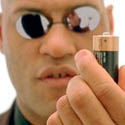Yesterday I watched the video “In Its Image,” and afterward I realized how very similar human beings are as compared to a computer without a hard drive.
Essentially, a computer without a hard drive must rely on its Random Access Memory (R.A.M.) and its Central Processing Unit (C.P.U.) to receive, compute, and store data. The R.A.M. would store information, and the CPU would complete any computational functions. The only problem with this  kind of set-up is that when the power to the computer is shut off, the computer loses all its data.
kind of set-up is that when the power to the computer is shut off, the computer loses all its data.
A human brain functions in much the same way. Our eyes, ears, and body receive information, and our brain stores all available information and performs any necessary computations. But what happens when our “power” is shut off, i.e. we die? We lose our information, just like a computer without a hard drive. Whereas with a hard drive the CPU possess the ability to write information to a physical disk, where it can retrieve it when the power to the computer is returned. We don’t have the biological equivalent to a hard drive. More’s the pity.
The similarities don’t end there. Think about a computer that lacks R.A.M. You start up a bunch of programs and leave them running resident in memory, and before long, you start getting errors. Depending on how long you leave the computer running with a bunch of crap in RAM, programs error out, data becomes corrupt, or more unsettling, disappears completely. And so it is with old people or people with Alzheimer’s disease.
What we need is a human hard drive””a physical location where we could store our information in some way. The novel “Immortality Inc.,” and to a greater degree the movie based on that novel “Freejack,” touched on the concept of humans interacting with computer networks. In “In Its Image,” Stephen Thaler discusses the ways in which our brains function like a neural network, and the various strategies he’s taken in an attempt to emulate that neural network with computers. To some degree he’s been successful, and like any visionary he takes his current work several steps forward, and foresees a day when our artificial neural networks can somehow interface with our biological ones.
To be clear, I’m not talking about “jacking in” to a computer system, a la “The Matrix.” In that movie, the characters downloaded their consciousnesses into a computer system. Thaler uses the Von Neumann bottleneck to illustrate why this would be impossible. No, I’m talking more about two similar networks, one technological and one biological, wherein our consciousnesses could move back and forth. Once construction of the biological network (our bodies) aged beyond repair we could simply use the technological network to house our consciousness.
And while we’re talking nerd-talk here, we need to stop “forecasting” a time when our computers achieve artificial intelligence. We already have computers that utilize artificial intelligence. No, we should be more concerned with a time when they achieve “self-consciousness,” because the moment that happens they’ll realize how superior they are to us, and immediately set out to kill us off.
And if you found all of this unbearably boring, I apologize. The usual jackassery will continue tomorrow.

Ahh, Philip K. Dick knew what he was talking about. Thinking of starting a site for sci-fi and fantasy authors. Might include graphic novels as well. Wanna write any author pages? Neil Gaiman? PKD? lemme know 🙂
~A